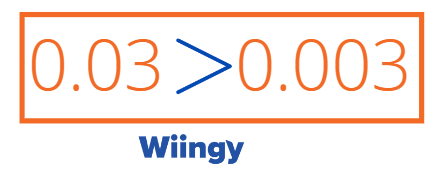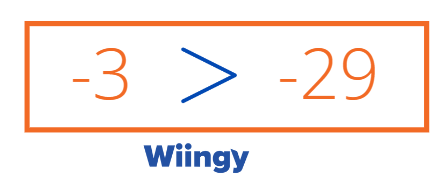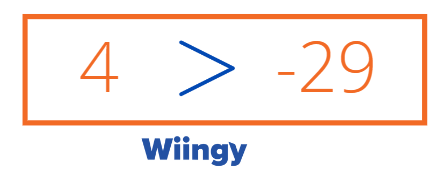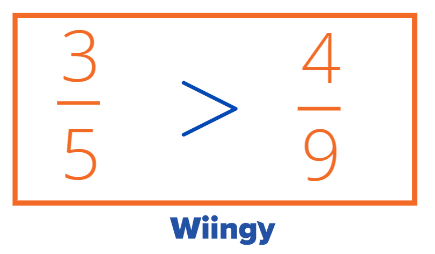Maths
Greater Than Symbol – Definition, Meaning, Solved Examples
Written by Prerit Jain
Updated on: 23 May 2023
Contents
Greater Than Symbol – Definition, Meaning, Solved Examples
In mathematics, the greater than symbol is defined as a term that is used to compare two given values, fractions, or quantities, where one value or quantity is greater than the other. When we need to check which of the two given values is greater than the other, we use the greater than symbol. While using this symbol, we should always focus on the left side of the symbol and compare it with the right side of the symbol. The greater than symbol is represented by “>.”
This Maths symbol helps in comparing two quantities, which leads to the development of a child’s number sense. Children need to develop this number sense because it helps them recognize numbers and the relationships between two numbers. Apart from this, the greater than symbol can also be used for the representation of a series of descending numbers from a greater to a smaller number.
Looking to Learn Math? Book a Free Trial Lesson and match with top Math Tutors for concepts, homework help, and test prep.
Greater than symbol in Maths
The greater than symbol in Mathematics is represented as “>”.
How to use the greater than symbol for different numeric values and quantities?
Let us understand how to use the greater than symbol for various numerical values and quantities from the below:
Greater than symbol with a whole or natural number
The greater than symbol is used directly by pointing towards the greater value among the given values.
For example, if there are two numbers, 8 and 15, and we have to represent the greater number among the two numbers using the greater than symbol. By looking at the numbers, it is obvious to tell that 15 is greater than 8. Using the greater than symbol, it can be represented as 15 > 8.

Greater than symbol with decimal numbers
The greater than symbol almost works the same way as it works with natural or whole numbers. The symbol simply points towards the greater value among the given values.
For example, if there are two decimal numbers, 0.003 and 0.03, and we have to represent the greater number among the two numbers using the greater than symbol. By looking at the numbers, it is obvious to tell that 0.03 is greater than 0.003. Using the greater than symbol, it can be represented as 0.03 > 0.003.

Greater than symbol with integers
Integers are negative and positive numbers, including 0. In the case of negative numbers, the greater than symbol is used by pointing towards the least value among the given values, because when we deal with negative numbers, a smaller number is treated as a greater number. Hence, -1 is the greatest negative number.
Positive numbers, including zero, are considered natural and whole numbers, and the working of the greater than symbol with these numbers is already explained above.
For example, if there are two numbers, -3 and -29, and we have to represent the greater number among the two numbers using the greater than symbol. Because the numbers have a negative sign, the smaller number is considered greater. Hence, -3 is greater than -29. Using the greater than symbol, it can be represented as -3 > -29.

Let’s take another example. Suppose there are two numbers -29 and 4, and we have to represent the greater number among the two numbers using the greater than symbol. Here, 4 is greater than -29 because when we compare a positive number with a negative number, positive numbers are always greater than negative numbers. Using the greater than symbol, it can be represented as 4 > -29.

Greater than symbol with fractions
First, we need to convert the fractions into natural numbers. So, for that, we cross multiply the fractions, that is, we multiply the numerator of the first fraction with the denominator of the second fraction to get the first number. Similarly, we multiply the numerator of the second fraction with the denominator of the first fraction to get the second number. And finally, we compare the two newly obtained numbers using the symbol.
For example, if there are two fractions, 4/9 and 3/5, and we have to represent the greater fraction among the two fractions using the greater than symbol.
Since both denominators are different, we will rationalize them. The steps to rationalize them are given below:
4/9 x (5 / 5) and 3/5 X (9/9)
20/45 and 27/45
Now we have 45 as the denominator for both numbers. Now check the numerator and it is clear that 27 is the highest number when compared to 20. Hence 3/5 > 4/9.

Greater than symbol with different quantities
We always need to focus on the units. For both the given quantities, they should have the same unit. Only then can we determine which quantity is greater than the other.
For example, if there are two quantities, 1 kilogram, and 200 grams, and we have to represent the greater quantity among the two given quantities, we use the greater than symbol. So, first, we will make sure that both quantities have the same unit. Here, we either need to convert kilograms to grams or grams to kilograms. When converting 1 kilogram to grams, it will be equal to 1000 grams.
Now, we will have to do a comparison between 1000 g and 200 g. It is pretty clear that 1000 grams are greater than 200 grams. Using the greater than symbol, it can be represented as 1000>200.
Solved Examples
Question 1: Write the following numbers in descending order using the greater than symbol.
2, 7, 1, -8, 16, 0, 9, -3
Solution:
Descending order refers to the arrangement of numbers from the highest number to the lowest number.
It is clearly visible that among all the given numbers, 16 is the greatest number and -8 is the lowest number.
So, the numbers can be represented in descending order as
16 > 9 > 7 > 2 > 1 > 0 > -3 > -8
Question 2: Fill in the blank spaces with suitable symbols.
(a) 9 ___ 1+3
(b) 5 ___ -7
(c) 99 ___ 92+7
(d) -2 ___ -10
Solution:
(a) 1 + 3 = 4
On comparing 9 and 4, it is clear that 9 is greater than 4.
So, 9 > 4
(b) On comparing 5 and -7, it is clear that 5 is greater than -7 because positive numbers are always greater than negative numbers.
So, 5 > -7
(c) 92 + 7 = 99
On comparing 99 and 99, it is clear that both are equal.
So, 99 = 99
(d) On comparing -2 and -10, it is clear that -2 is greater than -10 because, in negative numbers, a smaller number is treated as a greater number.
So, -2 > -10
Looking to Learn Math? Book a Free Trial Lesson and match with top Math Tutors for concepts, homework help, and test prep.
FAQs
What do you mean by the greater than symbol and when do we use it?
The greater than symbol is used to compare any two numbers, fractions, or quantities. When we need to check whether the first number, out of the two given numbers, is greater than the second number or not, we use the greater than symbol. It is represented by “>”.
What is greater than or equal to the symbol?
The greater than or equal to symbol is also used to compare any two numbers, fractions, or quantities. When we need to check whether the first number, out of the two given numbers, is greater than or equal to the second number or not, we use the greater than or equal to symbol. It is represented by “≥”.
What is the difference between the greater than and the greater than or equal to symbol?
The major difference between the greater than and the greater than or equal to symbol is that the greater than symbol is used when we need to check whether the first number, out of the two given numbers, is greater than the second number or not. While, the greater than or equal to symbol is used when we need to check whether the first number, out of the two given numbers, is greater than or equal to the second number or not.
Which is greater between 4 and -99?
Positive numbers are always greater than negative numbers, so here 4 is a positive number and -99 is a negative number.
Hence, 4 > -99
What is greater between 5/9 and 2/7?
To make a comparison between fractions, we need to rationalize them.
5/9 x (7/7) and 2/7 (9/9)
35/63 and 18/63
Now both numbers have the same denominator.
Hence 35/63 > 18/63.
We hope this article is helpful to you in answering all the queries related to the greater than symbol!

Written by by
Prerit Jain
